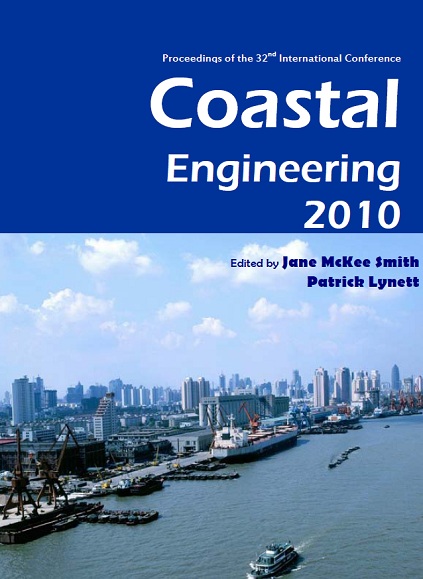Abstract
Based on integrated vertically averaged free-surface and subsurface model, detailed analysis was focused on the water fluctuation in the enclosed lagoon caused by tidal movement. It is shown that when porosity of sand is increased, the water storage capacity in sand beach will be increased and the amplitude of vibration in the lagoon will be decreased. On the contrary, when permeability coefficient is increased, the amplitude in lagoon will be increased, and the phenomena of phase lag will be reduced either. Research reveals there is periodical water exchange between lagoon and out sea on the two sides of the sand beach. The procedure of water going into the lagoon happens differently from that of water coming out from lagoon. Because there is over-height in the lagoon, the time of water transporting from the lagoon to the out sea is longer than the reverse procedure and the maximum of water flux in the first procedure is shorter than the later. Further more the water moving from lagoon to open sea usually happens in the initial stage of flood and later stage of ebb, while the reverse procedure happens in the later stage of flood and initial stage of ebb.References
Casulli, V., Stelling, G. S.,1998. Numerical simulation of three-dimensional quasi-hydrostatic, free surface flows, Journal of Hydraulic Engineering, 124, 678-686.http://dx.doi.org/10.1061/(ASCE)0733-9429(1998)124:7(678)
Ebrahimi, K., Falconer, R.A., Lin, B., 2007. Flow and solute fluxes in integrated wetland and coastal systems, Environmental Modeling & Software, 22,1337-1348.http://dx.doi.org/10.1016/j.envsoft.2006.09.003
Huang, C.J., Chang, H. H., 2003.Structural permeability effect effects on the interaction of a solitary wave and a submerged breakwater, Coastal engineering,49, 1-24.http://dx.doi.org/10.1016/S0378-3839(03)00034-6"
Kong, J., Xin, P.,Song, Z.Y., Li, L.,2010. A new model for coupling surface and subsurface water flows: with an application to a lagoon, Journal of Hydrology, 390,116-120.http://dx.doi.org/10.1016/j.jhydrol.2010.06.028
Leticia,B.R.,Pablo,A.C.,Carlos,A.V.,2008. Full conservative coupling of HEC-RAS with MODFLOW to simulate stream-aquifer interactions in a drainage basin, Journal of Hydrology, 353(1-2), 129-142.http://dx.doi.org/10.1016/j.jhydrol.2008.02.002
Liang, D., Falconer, R.A., Lin, B., 2007. Coupling surface and subsurface flows in a depth averaged flood wave model, Journal of Hydrology, 337, 147-158.http://dx.doi.org/10.1016/j.jhydrol.2007.01.045
Mcdougal,W.G.,1993. State of the art practice in coastal engineering, Lecture Notes, National Cheng Kung University, Taiwan, 10.25-10.28.
Panday,S.,Huyakorn,P.S.,2004.A full coupled physically-based spatially distributed model for evaluating surface/subsurface flow, Advance in Water Resource, 27(4),361-382.http://dx.doi.org/10.1016/j.advwatres.2004.02.016
Walters, R.A., Emmanuel,H., Pietrzak J., Le Roux D.Y.,2009. Comparison of unstructured, staggered grid methods for the shallow water equations, Ocean Modelling,28,106-117.http://dx.doi.org/10.1016/j.ocemod.2008.12.004
Yuan, D., Lin, B., Falconer, R.A., 2008. Simulating moving boundary using a linked groundwater and surface water flow model, Journal of Hydrology, 349, 524-535.http://dx.doi.org/10.1016/j.jhydrol.2007.11.028
Zhang, Y., Baptista, A.M., Myers, E.P., 2004. A cross-scale model for 3D baroclinic circulation in estuary-plume-shelf systems: I. Formulation and skill assessment, Continental Shelf Research, 24, 2187-2214.http://dx.doi.org/10.1016/j.csr.2004.07.021

